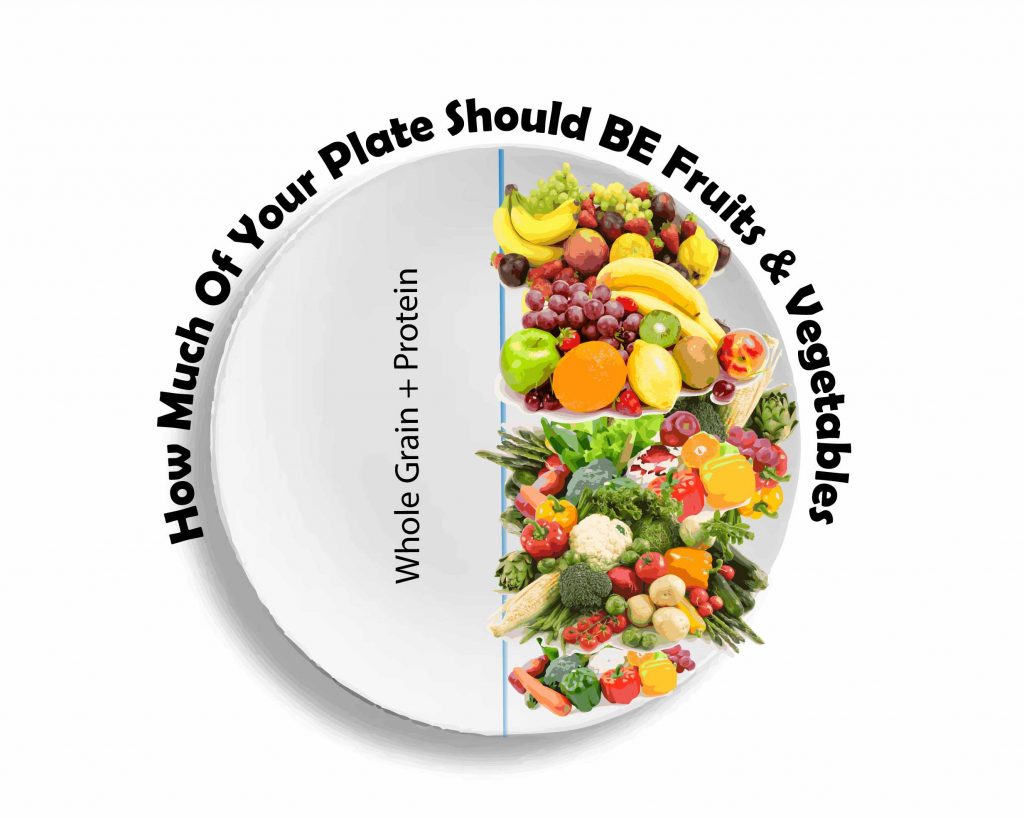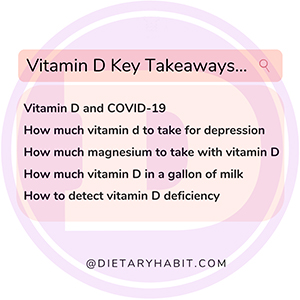How Much Of Your Plate Should Be Fruits and Vegetables

It’s a cliché to talk about the importance of eating fruits and vegetables. Everybody knows, yet 9 in 10 American adults choose to ignore it. According to CDC’s weekly morbidity and mortality report, only 12.2% of American adults meet the recommended intake of fruits, whereas only 9.3% consume recommended amount of vegetables. Lack of fruits and vegetables on your meal plate is one of the major causes behind the recent surge in non-communicable diseases. But why is that? Don’t you know how much of your plate should be fruits and vegetables?
If that’s the case here, we’ll make you clear about how much of your plate should be filled with fruits and vegetables. You can take it to the next level by maintaining the right proportion of foods in your platter.
If you can add colorful varieties like pink, green, blue, yellow, or red fruits and vegetables on the table, it’ll help you build a good dietary practice. It’s time you converted your fruit and vegetable choices into habits.
Factors behind How Much of Your Plate Should Consist of Fruits & Vegetables
Your meal plate should reflect your wisdom on choosing different foods. Hence fruits and vegetables are worth greater importance due to their extraordinary nutrient composition. But how much of your plate should consist of fruits and vegetables?
Though there’s a generalized concept about it, you’ve to know which factors can affect intake since it varies to an extent. When you know the factors, you can easily evaluate what percentage of “MyPlate” should be fruits and vegetables.
Age
Age is definitely a factor you should consider before consuming fruits and vegetables. When a child needs 1 to 1½ cups of fruits, an adult man might need 2 to 2½ cups. The contour of a child is way smaller than an adult person. So the stages of physical development like toddlers, children, adolescents, adults, and old stages impact how much of your plate should be fruits and vegetables.
Height
If you’re a taller and heavy person, you’ll need more calories due to the higher metabolism rate in your body. A leaner or shorter person will need a relatively low amount of fruits and vegetables.
Weight
Weight also determines the level of intake of fruits and vegetables. Usually, the average calculations are done imagining a 70-kg person. An adult man typically needs 2 to 2½ cups of fruits and 3 to 4 cups of vegetables.
If you weigh more than that, you need to increase the amount. Otherwise, you might suffer from malnutrition if such a diet persists for long. If you’re not such heavy as 70 kg, you’ll need less. However, eating more fruits and vegetables is never a bad option.
Sex
Men and women are different in many aspects, especially physique. A same-weight man has more muscles than a woman. So a man needs more fruits and vegetables to meet his daily requirement where a woman can suffice her needs with a small amount. A teenager girl needs only 1½ to 2 cups of fruits, while a teenager boy needs 2 to 2½ cups. The same thing goes for vegetable intake. Men need more than women.
Choice of Food
I firmly believe propaganda for foods has significant effects on a population. Whenever you open a TV channel or any media, you’ll see lots of advertisements promoting all the junk and unhealthy foods in the world. Maybe it’s your favorite coca-cola or a KFC burger. Even though these foods impact health, people won’t hesitate to buy them.
It’s because the negative propaganda has outnumbered the positive ones. The authority should involve influential faces in their campaign more intricately. If they become more public-oriented, they can pursue American adults to add more fruits and vegetables to their plate.
Availability
Availability is a barrier to a proportional meal platter. Fruits and vegetables are abundant in season. But it isn’t easy to find your favorite ones when the season goes by. I’m afraid that you might not love all the seasonal fruits. You may want your favorite orange or lettuce more on the table than the others.
If they’re not at your arm’s distance, you might discontinue the habit of putting more fruits and vegetables on the meal plate. Try to be more intimate with different types of fruits and vegetables so that they can come in handy when you need them. Some areas are barren to produce fruits and vegetables. If you’re lucky to have fresh fruits and vegetables in your backyard, then use them to the best.
Level of physical activity
Physically active people will need more fruits and vegetables than sedentary workers. As per the suggestions of the US Agriculture Department, half of your meal plate should be fruits and vegetables. That means a significant portion of your total calories should come from fruits and vegetables.
If you do a workout or heavy works, keep a larger portion of your plate fruits and vegetables, including proteins and starch parts. Most of the time, a minimum amount will be enough if you do a desk job. However, if you love eating fruits and veggies, you can continue.
Price
Price plays a significant role in maintaining a healthy diet. In the off-season, we see price hikes of fruits and veggies. It’s a hard job for an average Joe to include fruits and vegetables after decorating it with proteins and whole grains. That’s why malnutrition is prominent in low-income areas. However, a little research will help you which fruits and vegetables in your nearby market are on a budget.
How Much Of Your Plate Should Be Fruits and Vegetables
How much of your plate should be fruits and vegetables? It’s a straightforward concept as the answer is loud and clear. Fruits and vegetables should be half of your plate, while the other half should contain protein and starch. Thus it’ll make a great meal plate containing all the essential nutrients. The green part, which consists of vegetables, should be 30%, while the red part consisting of fruits should be 20%. But how many servings of fruits and veggies? Servings may vary, but you need to measure it in cups, as mentioned everywhere.
How Much Veg Should Be On Your Plate
According to the recommendation of the US Department of Agriculture, an adult woman needs 2 to 3 cups of vegetables as a daily requirement, and an adult man needs 3 to 4 cups, on the contrary. But the number of servings varies significantly in different vegetables.
A piece of broccoli equals 1 cup when raw leafy greens amount to 2 cups. If you add a cooked plantain to your meal plate, it’ll amount to ¾ cup. You can find the entire veg chart in MyPlate issued by USDA. It’ll be wise to switch between different color variations of the vegetables as each color contains unique and various nutrients.
How Much Fruit Should Be On MyPlate
You can have the fruits in several servings a day. The recommended amount of fruits and vegetables for an adult man is 2 to 2½ cups, and for women, it’s 1½ to 2 cups. You can pick among the rainbow of fruits to avoid monotony in eating.
If you have small-sized fruits, you’ll need 3 plums, 7 strawberries, 5 fresh figs, 14 cherries, or 10 dates that equal 1 cup of fruits. Apple, banana, or oranges are medium-sized fruits, and they are usually equal to 1 cup. If you’re into large fruits like grapefruit, watermelon, or papaya, you should take only half or slices of them to equal a cup. Dried fruits will fill in more in a cup measurement. You should avoid them as they are responsible for tooth decay that might create sensitivity to cold water.
Wrap Up
You can explore the official site MyPlate where you’ll get more about the servings of fruits and vegetables. If half of your plate consists of fruits and vegetables, you won’t need to worry about how much of your plate should be fruits and vegetables. Fruits and vegetables stay for a longer period in your stomach. Alternating between colorful fruits and vegetables will keep you motivated towards a healthy eating habit.



